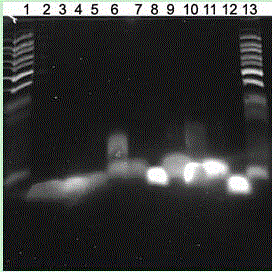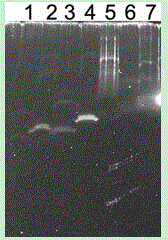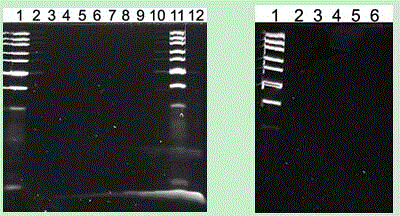Method for dyeing short-chain oligonucleotide through fixation of methanol and anthocyanidin
An oligonucleotide and anthocyanin technology, which is applied in the field of short-chain oligonucleotide methanol-fixed anthocyanin staining method, can solve the problem that short-chain oligonucleotides cannot be effectively detected, oligonucleotides cannot be detected, and The problem of short oligonucleotide fragments, etc., achieves the effect of less sample amount, improved sensitivity, and fewer operation steps.
- Summary
- Abstract
- Description
- Claims
- Application Information
AI Technical Summary
Problems solved by technology
Method used
Image
Examples
Embodiment 1
[0029] Embodiment 1 dyeing effect experiment
[0030] Experimental reagent: oligonucleotide to be tested is oligo C 6 G 2 , oligo C 5 G 3, oligo C 4 G 4 , oligo C 3 G 5 , oligo CGCG 5 , oligo (CG 3 ) 2 , oligo (ACG) 3 、oligo T 9 、oligo A 7 C 4 , oligo(A 5 T), oligo (ACGT) 2 , oligo C 8 , oligo C 7 , oligo C 6 , oligo C 5 、oligo T 7 、oligo T 6 and oligo T 5 , synthesized by Shanghai Sangon, its sequence is shown in Table 1. Acrylamide, methylene bisacrylamide, urea, Tris, Na 2 EDTA·2H 2 O, boric acid, methanol, acetic acid, tetramethylethylenediamine (TEMED), ammonium persulfate, formamide and bromophenol blue were all of analytical grade and were purchased from Shanghai Sangong. SDNAClear Nucleic Acids Stain Dye and SYBR Green II RNA gel stain were purchased from Shanghai Sangon and Beijing Suolaibao Technology Co., Ltd., respectively.
[0031] Experiment 1: on oligo C 6 G 2 , oligo C 5 G 3 , oligo C 4 G 4 , oligo C 3 G 5 , oligo CGCG 5 , oli...
Embodiment 2
[0059] Example 2 Dyeing Sensitivity Experiment
[0060] The staining result of embodiment 1 shows that the present invention can detect the oligonucleotide of 5-11 base length, now with oligonucleotide oligo A 11 As a standard sample, the sensitivity of the method of the present invention is further detected: the experiment is divided into an experimental group and a control group. Experimental group oligo A 11 The loading amount of the sample was 0.01, 0.02, 0.04, 0.06, 0.08, 0.1, 0.2, 0.4, 0.6, 0.8 and 1 μg; the control group oligo A 11 The sample loadings were 2 μg, 4 μg, 6 μg, 8 μg and 10 μg in sequence. The concentration of the denaturing polyacrylamide gel was 15%, the voltage was 200V, and the electrophoresis was performed for 1 hour at 25°C. After the electrophoresis, the experimental group first fixed the oligonucleotides with methanol fixative, and then stained with SDNAClear Nucleic Acids Stain Dye, while the control group did not fix with methanol, and directly ...
PUM
 Login to View More
Login to View More Abstract
Description
Claims
Application Information
 Login to View More
Login to View More - R&D
- Intellectual Property
- Life Sciences
- Materials
- Tech Scout
- Unparalleled Data Quality
- Higher Quality Content
- 60% Fewer Hallucinations
Browse by: Latest US Patents, China's latest patents, Technical Efficacy Thesaurus, Application Domain, Technology Topic, Popular Technical Reports.
© 2025 PatSnap. All rights reserved.Legal|Privacy policy|Modern Slavery Act Transparency Statement|Sitemap|About US| Contact US: help@patsnap.com



